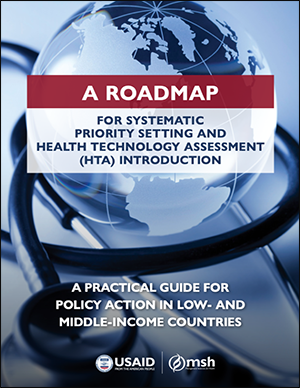Moving LMICs toward Self-Reliance: A Roadmap for Systematic Priority Setting for Resource Allocation
Moving LMICs toward Self-Reliance: A Roadmap for Systematic Priority Setting for Resource Allocation

Low- and middle-income countries (LMICs) struggle to reach and sustain universal health coverage (UHC) due to limited and inefficient allocation of resources. Their health systems are strained by a dual burden—continuing to manage infectious diseases, such as HIV, TB, and malaria, while responding to the prevalence growth of noncommunicable diseases, such as diabetes and cardiovascular conditions. COVID-19 is placing even more demands on already stretched resources. Systematic priority setting through the use of health technology assessment (HTA) is part of the policy ammunition at the disposal of those making such difficult distributional calls in these settings.

Roadmap for Systematic Priority Setting and Health Technology Assessment (HTA) serves as a practical guide for policy action in LMICs to successfully implement HTA and paves a road to a journey to sustainable UHC and self-reliance. Developed by Management Sciences for Health (MSH) and the USAID Medicines, Technologies, and Pharmaceutical Services (MTaPS) Program, with contributions from global experts in this field, this roadmap will help countries institutionalize their mechanisms, processes, and institutions to better use evidence and data to inform their resource allocation decisions.
HTA is a means of informing a systematic and transparent priority setting processes. HTA uses explicit methods to determine the value of a health technology, such as a drug, vaccine, diagnostic test, medical device, or procedure, at different points in its lifecycle to promote an equitable, efficient, and high-quality health system (INAHTA, 2020). Considerations of equity, ethics, justice, and the societal impact of decisions are integral to a robust HTA process, as are scientific evaluations of health benefits through comparative assessment.
Creating the Roadmap
To undertake policy action in LMICs, MSH, MTaPS, and our contributors adapted the stages (heuristic) model of the policy process as a framework to simplify policy making for HTA (see the Framework for Institutionalizing HTA graphic). We structured our approach around the four main stages of this policy approach and contextualized it around the specific features of HTA: agenda setting, formulation, adoption/implementation, and impact evaluation.
Health-related policy making is not always straightforward, and the roadmap’s stepwise approach to HTA implementation helps countries take advantage of existing tools to create or seize political momentum favoring HTA as a potential problem solution.
A Framework for Institutionalizing HTA
![[Castro HE, Kumar R, Suharlim C, et al. 2020. A Roadmap for Systematic Priority Setting and Health Technology Assessment (HTA). Arlington, VA: USAID/MSH, 2020.]](https://msh.org/wp-content/uploads/2020/09/figure1_pat_817px_0.png)
The Scope of the HTA Roadmap
The roadmap presents tools to support users in deciding why, when, and how to develop their own HTA methods. It builds on local capacity and benefits from global collaboration, with a focus on the use of HTA in LMICs to:
- Support resource allocation decisions
- Identify best-buy medications in essential medicines lists
- Support the design of health-benefit packages
- Assess the value of public health interventions
- Design investment cases for donors across disease areas
HTA: Why, When, and How
The ‘why’ and ‘when’ of utilizing or advancing HTA are shaped by the priorities and agenda of the stakeholders involved. The motivators for any country to adopt and institutionalize HTA may include the need to better inform resource allocation decisions; to improve the credibility, accountability, and transparency of the decision making process as a whole; and to provide better quality health services. Understanding what drives HTA policy change can help in creating useful strategies to advance it.
The ‘how’ of HTA relates to its scope and methodological approach, which are influenced by drivers such as contextual needs, data availability, and local capacity.
A robust HTA process consists of different steps: topic selection, assessment, appraisal, deliberation, and decision making. The international community and HTA-specialized networks have developed frameworks to strengthen each of these stages. HTA also requires an institutional structure and technical capacity to support its application.
Succeeding with HTA: Three Insights for LMICs
1. Invest in raising awareness
Early in the HTA development process, commit resources to raising awareness among decision makers about the usefulness, limitations, and potential impact of HTA. As awareness increases, so will uptake, linkages to decision making, and enforcement of the HTA process.
2. Start with what you have
When advancing systematic priority setting and HTA in LMICs, keep in mind existing practices, policies, capacities, and institutions. Defining the institutional arrangements for conducting HTA is a good starting point. The lesson for LMICs? HTA institutional structures will develop and evolve based on local needs, existing capacities, and political dynamics.
3. Make a business case for HTA
As with other institutional capacities related to UHC and the road to self-reliance, countries and implementing partners must define key milestones and performance indicators to evaluate the impact of HTA. HTA is critical to decision making, but proving that it is ‘good value for money’ requires assessing its impact as a policy solution as well. Measuring the impact of HTA can help ensure buy-in and long-term financial sustainability.
Getting Started
HTA, like any other policy process, is dynamic and subject to the contestability of various issues competing to capture the attention of policy makers to be considered in the political agenda. Throughout the roadmap, we have considered the importance of the context, actors, and processes that would be involved into the process of advancing systematic priority setting and HTA in LMICs. We envision a pragmatic and incremental pathway in which HTA units in LMICs will start small with basic methods for assessing, appraising, and linking evidence into decisions and over time, evolve and grow, building their capacity to serve the needs of the health system and putting countries on a path toward sustainable UHC and self-reliance.
A Roadmap for Systematic Priority Setting and Health Technology Assessment (HTA) was developed by Management Sciences for Health (MSH) and the USAID MTaPS Program, with contributions from subject experts from Fudan University, University of Washington, the International Society for Pharmacoeconomics and Outcomes Research, the International Network of Agencies for Health Technology Assessment, OSTEBA – Basque Office for HTA, Health Technology Assessment International, the Center for the Evaluation of Value and Risk in Health at Tufts Medical Center, Radboud University Medical Centre, York University, the Center for Global Development, and Imperial College London.
The MTaPS program is a five-year program (2018–2023) funded by USAID and is aimed at helping LMICs strengthen their pharmaceutical systems to ensure sustainable access to and appropriate use of safe, effective, quality-assured, and affordable essential medical products and pharmaceutical services.
